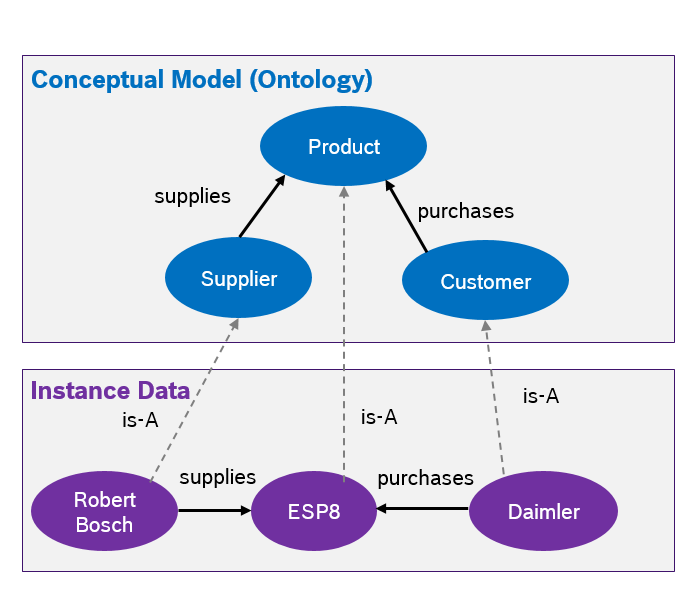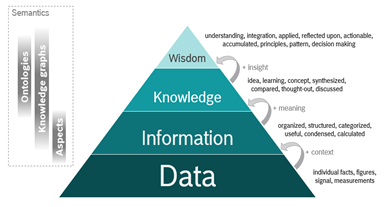Glossary
For the purposes of this technical documentation for Bosch Semantic Stack software, the following terms and definitions apply.
| Term | Definition |
|---|---|
The means to access a software service or library. |
|
It is a software application on top of Bosch Semantic Stack that can also include custom models and data. |
|
“As engineered” data refers to new and existing engineering data. |
|
“As operated” data originates from the product being operated and used in the field after it has been produced. |
|
“As produced” data originates from the manufacturing process as well as manufacturing systems, such as MES or ERP. |
|
An aspect is a domain-specific view on information and functionality associated with a specific digital twin with a reference to a concrete Aspect Model. An aspect is a software service to retrieve data at runtime or live data of a Twin (current or aggregated) from a data source or to trigger operations. Thus, an aspect is built with an implementation that ensures that the exchanged data is compliant to the specification of the referenced Aspect Model via a defined interface. Aspects are registered (incl. their “API endpoint” information) with the Twin to which they belong in the Digital Twin Registry. See also the Aspect concept description. |
|
Implementing an aspect means to provide an interface (API) which offers meaningful data for consumption. Therefore, an aspect implementation includes:
|
|
An Aspect Model is a formal, machine-readable semantic description of data accessible from an aspect. An Aspect Model must adhere to the Semantic Aspect Meta Model (SAMM), i.e., it utilizes elements and relations defined in the Semantic Aspect Meta Model and is compliant to the validity rules defined by SAMM. Aspect Models are logical data models which can be used to detail a conceptual model in order to describe the semantics of runtime data related to a concept. Further, elements of an Aspect Model can/should refer to terms of a standardized Business Glossary (if existing). Aspect Models can be created using the Aspect Model Editor and are managed in the Aspect Model Catalog. See also the Aspect Model concept description. |
|
The Aspect Model Catalog is the central persistence and point of reference for all Aspect Models. It is a browsable repository/collection which provides the functionality to manage the lifecycle of the stored artifacts (e.g., versioning, publishing, and releasing of Aspect Models). See also Aspect Model Catalog |
|
The Aspect Model Editor (AME) is the visual editor for Aspect Models to be used in Bosch Semantic Stack. See also the Aspect Model Editor documentation |
|
Standardized digital representation of an asset [SOURCE: IEC 63278-1:2023, 3.1.2] |
|
Object containing the Asset Administration Shell’s identification and endpoint information [SOURCE: IDTA-01002-3-0, 6.2.4] |
|
An asset is a physical object that is identifiable and can be represented by one or more digital twins, such as a machine or a sensor. |
|
In March 2023 BAMM was replaced with SAMM. |
|
The customer is a legal entity consuming our services. The user can be the end user or developer using a digital twin, platform- or system component in general. |
|
Analytics is the systematic computational analysis of data or statistics. We make data available in a semantic way to then apply analytic technologies to gain knowledge. |
|
Data-driven business is a scenario to drive external business and achieve new revenue. |
|
Data-driven operations is a scenario to achieve and increase internal efficiency. |
|
A data model reflects the desired structure of data for a specified domain. Data models define business meaning of the source data. They describe the concepts, attributes, and relationships in or across data sets. |
|
A digital twin is a virtual identifiable representation of a real-world entity or process, synchronized at a specified frequency and fidelity. For example,
The properties of a digital twin include at least the explicit relationship to the concrete asset that the digital twin represents. Digital twins are motivated by outcomes, tailored to use cases, powered by integration, built on data, guided by domain knowledge, and implemented in IT/OT systems. In Bosch Semantic Stack, a Digital Twin can aggregate aspects, which are associated with the Twin in the Digital Twin Registry. Twins can be associated with an element of an ontology or knowledge graph providing additional context for the Twin. |
|
The Digital Twin Registry is the central registry which contains all digital twins and their aspects including information about the underlying asset, asset manufacturer, and access options (e.g., aspect endpoints). See also Digital Twin Registry. |
|
A specific area of expertise in a social or commercial institution. |
|
Domain knowledge is the knowledge of a specific, specialized discipline, profession, or activity, in contrast to general knowledge. |
|
The Eclipse Dataspace Connector provides a framework for sovereign, inter-organizational data exchange. |
|
A knowledge graph is an explicit, formal, and machine-readable specification of a shared conceptualization that defines domain concepts, attributes, and relationships among them = conceptual model (ontology). It usually contains instances of concepts = data. |
|
The local identifier is a set of key-value pairs which uniquely identifies the asset in the scope of a tenant. Local identifiers can be attached to digital twins in the Digital Twin Registry. See also local identifiers in the Digital Twin Registry usage guide. |
|
Any API which is based and generated of a conceptually or logically described data model. Aspects are per definition model-based APIs as they are based on Aspect Models. |
|
An ontology is a formal description of knowledge as a set of concepts within a domain and the relationships that hold between them. Source: https://www.ontotext.com/knowledgehub/fundamentals/what-are-ontologies/ |
|
A platform is a group of technologies that are used as a base upon which other applications, processes or technologies are developed. |
|
Result of the production and target of company division. Also, satisfaction of needs. Differentiation in assets (physical, durable, consumable), service (immaterial) and energy. |
|
Digital twin of a product instance. At Bosch, product instances are identifiable by their serial number (SN). |
|
Digital twin of a product type. At Bosch, product types are identifiable by their part number. |
|
RDF (Resource Description Framework) is a standard by the W3C to describe graph-based data. See
http://www.w3.org/TR/rdf11-concepts/ |
|
With runtime data we refer to the fact that this is data that will be provided via an API, ready for consumption at any time. The nature of the data may either be data that is changing rapidly (e.g. current temperature of an asset ), configuration data, or master data (which never changes for an existing asset). |
|
The Semantic Aspect Meta Model (SAMM) allows the creation of models to describe the semantics of digital twins by defining their domain-specific data which will be provided through aspects or Submodels. SAMM provides a set of predefined objects that allow a domain expert to define Aspect Models and complement a digital twin with a semantic foundation. SAMM was previously known as BAMM Aspect Meta Model. See also Semantic Aspect Meta Model (SAMM) |
|
Semantic data integration is a process that uses knowledge graphs to which data of original source systems is mapped using so-called mapping rules. |
|
The semantic data model is a method of structuring data that includes semantic information that adds a basic meaning to the data and the relationships that lie between them. Source: https://www.techopedia.com/definition/30489/semantic-data-model |
|
Also: semantically described information. Data that — within a certain context — has a particular meaning. |
|
Semantic interoperability denotes the ability of different applications and business partners to understand exchanged data in a similar way, implying a precise and unambiguous meaning of the exchanged information. Source: https://www.igi-global.com/dictionary/challenges-interoperability-ecosystem/26340 |
|
Bosch Semantic Stack is a semantic stack: software that supports implementing digital twins by delivering the necessary tools to create, manage, and utilize digital twins and their components while adding semantics to the data exchanged through digital twins. Bosch Semantic Stack includes the Digital Twin Registry and the Aspect Model Catalog. It is complemented by the open-source Semantic Aspect Meta Model (SAMM) specification, the Aspect Model Editor, and all related SDK functionality to utilize semantically described data provided by digital twins. |
|
Semantics is the study of meaning, reference, or truth. |
|
SHACL (SHApes Constraint Language) is a standard by the W3C to validate graph-based data in
RDF. See https://www.w3.org/TR/shacl/ |
|
A solution based on Bosch Semantic Stack is a software application including the model, data, semantic stack components, and other libraries. |
|
SPARQL (SPARQL Protocol and RDF Query Language) is a standard by the W3C to query graph-based data
in RDF format. See https://www.w3.org/TR/sparql11-query/ |
|
Object containing the Submodel’s identification and endpoint information [SOURCE: IDTA-01002-3-0, 6.3.4]. |
|
Template for the representation of an aspect of an asset [SOURCE: IEC 63278-1:2023, 3.1.27]. |
|
Turtle (Terse RDF Triple Language) is a standard by the W3C. The Resource Description Framework (RDF) is a general-purpose language for representing information in the Web. |
|
A use case is a usage scenario for a piece of software; to suggest a situation where a piece of software may be useful. The fulfillment of the need from a use case is reflect in a solution. |

